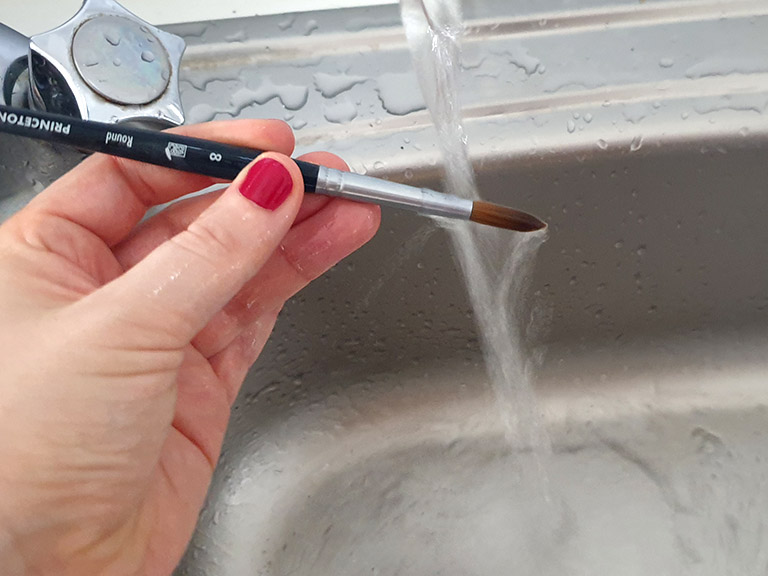Watercolour brushes are different from other paintbrushes like the ones for oils or acrylics – the brush bristles for watercolour are more delicate because the paint pigments are so fine. But this means they need to be treated and cared for more gently to stop them becoming damaged.
Proper care will help maintain their shape and stop the bristles from becoming loose, bent or rough. Here’s a step-by-step guide to looking after your watercolour brushes with daily cleaning and storage.
I’ve also added a bonus section at the end for steps to try and recover a damaged brush.
Never leave brushes standing in water
It’s vital that you don’t leave watercolour brushes stood up in the water jar – the bristles may warp and get stuck in a bent position. It can also damage the ferrule (the metal part holding the bristles) or cause the bristles to splay.
Lay your brushes flat on a paper towel when you’re not painting, to keep the shape intact.
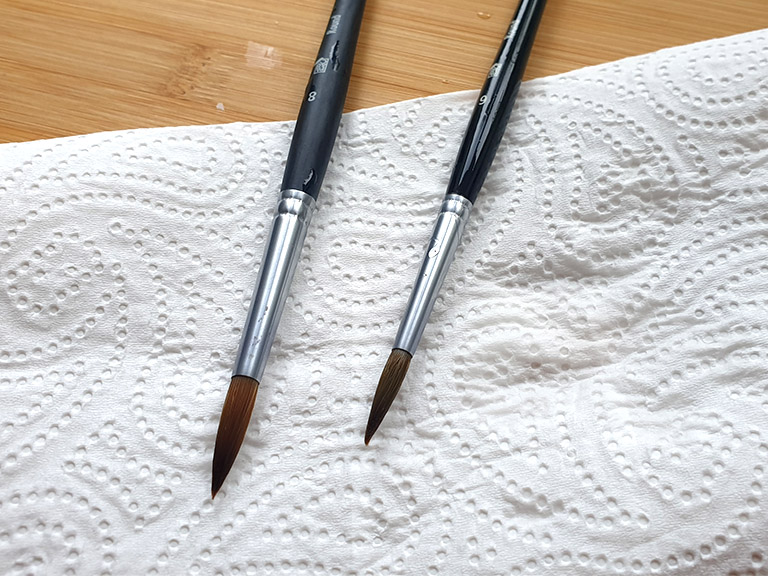
How to clean and rinse your watercolour brush
After you finish painting, rinse your brushes thoroughly in water to remove excess paint. I usually hold mine under a running tap and gently move the bristles back and forth, without bending too far. Repeat until the water runs clear. Gently squeeze out excess water and reform the bristles to their original shape.
Don’t use hot water or excessive force when cleaning your brushes, as this can cause the bristles to become misshapen or damaged.
How to use soap for cleaning brushes
If your brushes have gotten dry with paint still on them, or you were using very dark colours, you want to add a cleaner like a brush soap. This is specifically designed for paint brushes and is very gentle on your brushes. I’ve also used regular soap, but make sure it’s mild and unscented so you don’t damage the bristles or leave a residue behind.
Apply a small amount of brush soap, either directly on the bristles or diluted in a cup of water. Gently massage the bristles with your fingers to create a lather and remove any dried or caked paint. Rinse the brush thoroughly under running water to remove all soap and paint residue.
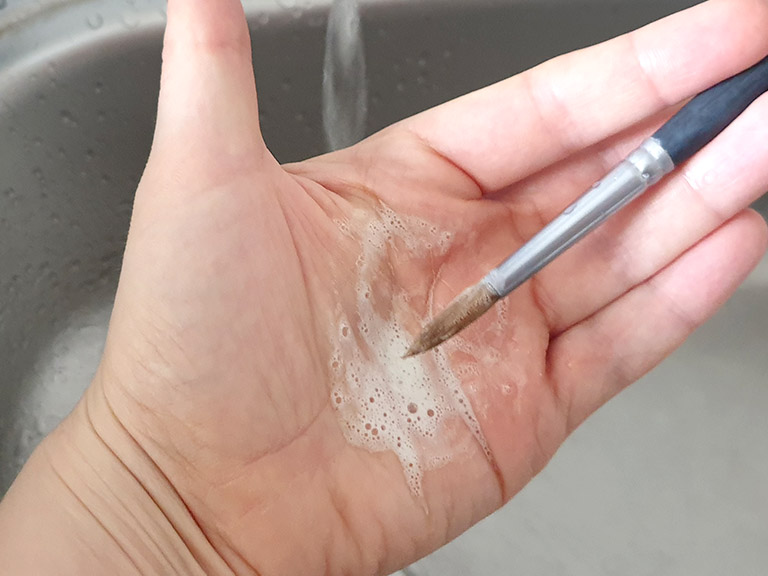
Drying watercolour brushes after cleaning
Don’t put brushes back into a pen pot with the bristles in the air to dry – there’s a risk that water could collect at the base of the bristles and cause rotting in the wooden handle.
There are two options for drying your brushes – lay them flat until dry or hang them upside down to dry. Some artists like to make a brush hanger using coiled wire that will hold onto the handles and let them drip dry.
Where to store watercolour brushes
Store your brushes in a dry place to avoid mould and mildew. Don’t shut them up in a drawer or any slight dampness may cause damage. Keep them away from direct sunlight or heat sources like a radiator, as this can cause the bristles to become stiff and misshapen.
Store your brushes in a cup or container with the bristles facing upward to keep them from getting bent or damaged.
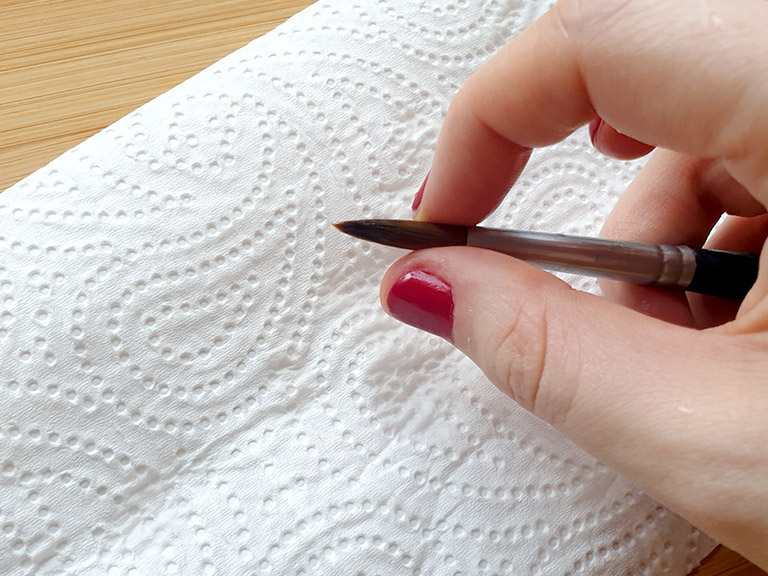
Maintaining your brush shape and condition
As you use your watercolour brushes, the bristles may fray over time. To keep your brushes in top condition, it may be necessary to trim the bristles occasionally with a pair of small scissors, like nail scissors.
To do this, hold the brush at a 45-degree angle and carefully trim off any bristles that are bent or poking out. Start by trimming a small amount and then reshape the bristles before trimming more, if necessary.
Help! My brush is bent and misshapen – can I fix it?
It really depends on how bad the damage is and what kind of brush it is – synthetic bristles or natural animal hair. Here are some tactics you can try, but there are no guarantees and remember that this is all at your own risk. Any harsh methods may further damage a brush.
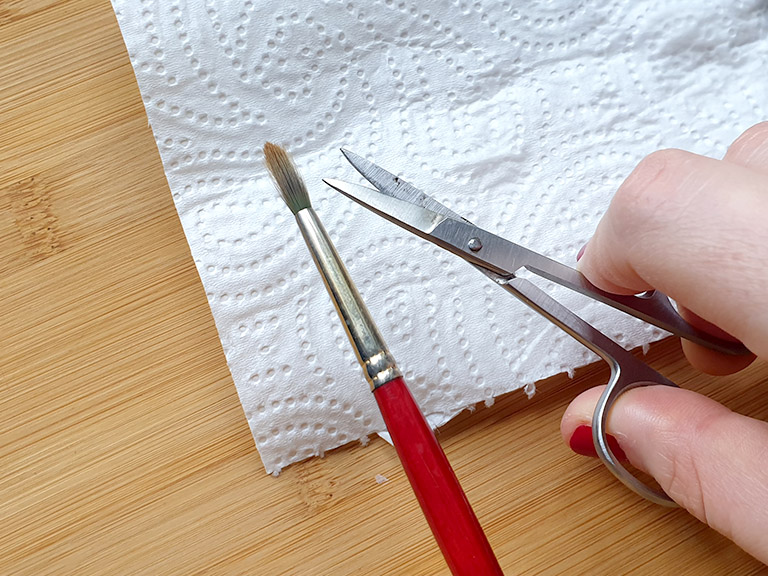
- Try hot water – swirl the brush around in hot (but not boiling) water to fix bent shapes. This works better on animal hair in my experience. And be careful not to hold it in the hot water too long or the brush bristles may become weak and start fraying.
- Seal with soap – some people swear by this! Wash your brush really well, then roll in a mild soap or specialist brush soap. Allow to dry with this the soap still on – it should set. Leave it overnight, then rinse off the soap in the morning and the shape may be reformed.
- Re-trim the shape – if your brush has really lost it shape, you might want to try cutting it into a new shape. This is more risky, because brush fibres naturally come to a very fine point – if you cut them with scissors, you’ll get a thick, abrupt end that won’t move the same way on the paper. But if you’re desperate to redeem something, it’s worth a shot.
If your watercolour brush has masking fluid stuck on it, unfortunately this can’t be removed at all. Read my guide to masking fluid for tips on how to protect your brushes.
I hope one of these methods works to save your damaged watercolour brush.
It’s important to always handle your brushes gently and store them carefully to prevent damage and keep your brushes in top condition to ensure that they last for years to come.
More watercolour supplies advice
Download my free watercolour supply guide
Feeling overwhelmed and confused by watercolour paints, papers and brushes? Download my free guide filled with insider info, including a list of good supplies for every budget, and my complete supply list!
